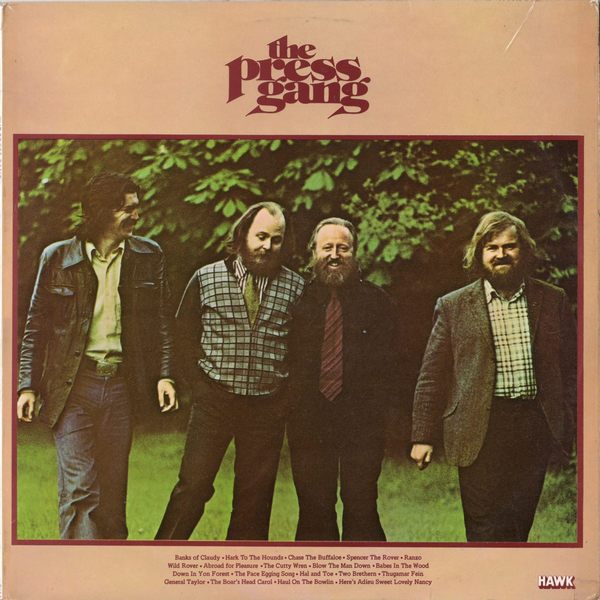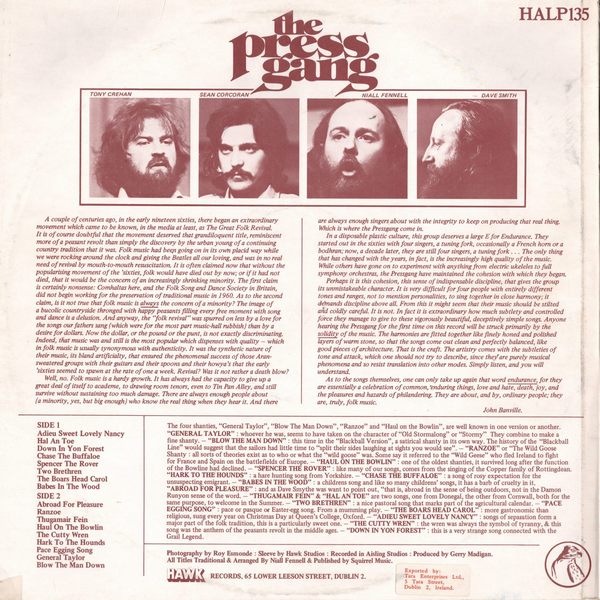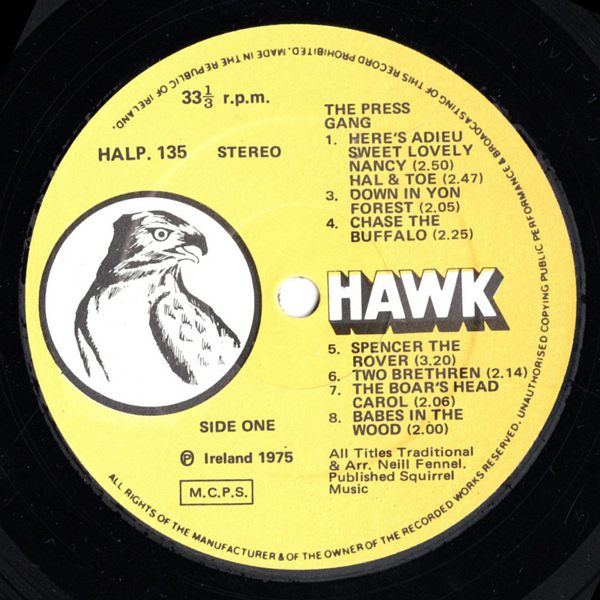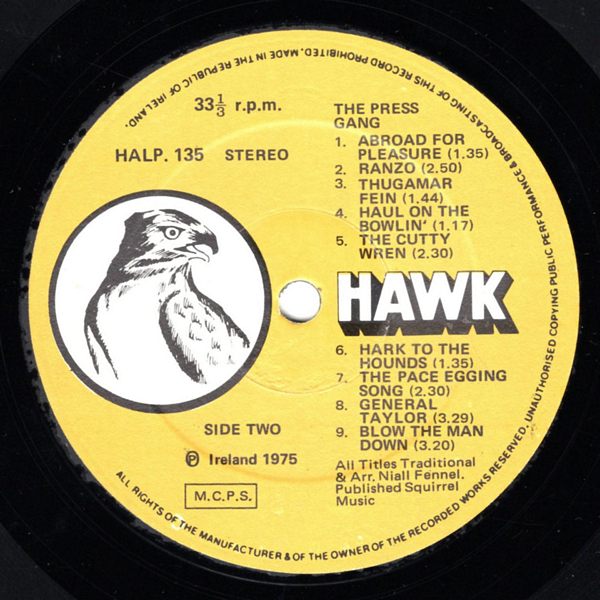
 |



|
Sleeve Notes
A couple of centuries ago, in the early nineteen sixties, there began an extraordinary movement which came to be known, in the media at least, as The Great Folk Revival. It is of course doubtful that the movement deserved that grandiloquent title, reminiscent more of a peasant revolt than simply the discovery by the urban young of a continuing country tradition that it was. Folk music had been going on in its own placid way while we were rocking around the clock and giving the Beatles all our loving, and was in no real need of revival by mouth-to-mouth resuscitation. It is often claimed now that without the popularising movement of the 'sixties, folk would have died out by now; or if it had not died, that it would be the concern of an increasingly shrinking minority. The first claim is certainly nonsense: Comhaltas here, and the Folk Song and Dance Society in Britain, did not begin working for the preservation of traditional music in 1960. As to the second claim, is it not true that folk music is always the concern of a minority? The image of a bucolic countryside thronged with happy peasants filling every free moment with song and dance is a delusion. And anyway, the "folk revival" was spurred on less by a love for the songs our fathers sang (which were for the most part music-hall rubbish) than by a desire for dollars. Now the dollar, or the pound or the punt, is not exactly discriminating. Indeed, that music was and still is the most popular which dispenses with quality — which in folk music is usually synonymous with authenticity. It was the synthetic nature of their music, its bland artificially, that ensured the phenomenal success of those Aran-sweatered groups with their guitars and their spoons and their howya's that the early 'sixties seemed to spawn at the rate of one a week. Revival? Was it not rather a death blow?
Well, no. Folk music is a hardy growth. It has always had the capacity to give up a great deal of itself to academe, to drawing room tenors, even to Tin Pan Alley, and still survive without sustaining too much damage. There are always enough people about (a minority, yes, but big enough) who know the real thing when they hear it. And there are always enough singers about with the integrity to keep on producing that real thing. Which is where the Pressgang come in.
In a disposable plastic culture, this group deserves a large E for Endurance. They started out in the sixties with four singers, a tuning fork, occasionally a French horn or a Bodhrán; now, a decade later, they are still four singers, a tuning fork … The only thing that has changed with the years, in fact, is the increasingly high quality of the music. While others have gone on to experiment with anything from electric ukuleles to full symphony orchestras, the Pressgang have maintained the cohesion with which they began.
Perhaps it is this cohesion, this sense of indispensable discipline, that gives the group its unmistakable character. It is very difficult for four people with entirely different tones and ranges, not to mention personalities, to sing together in close harmony; it demands discipline above all. From this it might seem that their music should be stilted and coldly careful. It is not. In fact it is extraordinary how much subtlety and controlled force they manage to give to these vigorously beautiful, deceptively simple songs. Anyone hearing the Pressgang for the first time on this record will be struck primarily by the solidity of the music. The harmonies are fitted together like finely honed and polished layers of warm stone, so that the songs come out clean and perfectly balanced, like good pieces of architecture. That is the craft. The artistry comes with the subtleties of tone and attack, which one should not try to describe, since they are purely musical phenomena and so resist translation into other modes. Simply listen, and you will understand.
As to the songs themselves, one can only take up again that word endurance, for they are essentially a celebration of common, enduring things, love and hate, death, joy, and the pleasures and hazards of philandering. They are about, and by, ordinary people; they are, truly, folk music.
John Banville.
The four shanties, "General Taylor", "Blow The Man Down", "Ranzoe" and "Haul on the Bowlin", are well known in one version or another.
GENERAL TAYLOR — whoever he was, seems to have taken on the character of "Old Stormalong" or "Stormy" They combine to make a fine shanty.
BLOW THE MAN DOWN — this time in the "Blackball Version", a satirical shanty in its own way. The history of the "Blackball Line" would suggest that the sailors had little time to "split their sides laughing at sights you would see".
RANZOE or "The Wild Goose Shanty — all sorts of theories exist as to who or what the "wild goose" was. Some say it referred to the "Wild Geese" who fled Ireland to fight for France and Spain on the battlefields of Europe.
HAUL ON THE BOWLIN — one of the oldest shanties, it survived long after the function of the Bowline had declined.
SPENCER THE ROVER — like many of our songs, comes from the singing of the Copper family of Rottingdean..
HARK TO THE HOUNDS — a hare hunting song from Yorkshire.
CHASE THE BUFFALOE — a song of rosy expectation for the unsuspecting emigrant.
BABES IN THE WOOD — a children's song and like so many children's songs, it has a barb of cruelty in it.
ABROAD FOR PLEASURE — and as Dave Smythe was want to point out, "that is, abroad in the sense of being outdoors, not in the Damon Runyon sense of the word".
THUGAMAIR FEIN & HAL AN TOE are two songs, one from Donegal, the other from Cornwall, both for the same purpose, to welcome in the Summer.
TWO BRETHREN — a nice pastoral song that marks part of the agricultural calendar.
PACE EGGING SONG — pace or pasque or Easter — egg song. From a mumming play.
THE BOARS HEAD CAROL — more gastronomic than religious, sung every year on Christmas Day at Queen's College, Oxford.
ADIEU SWEET LOVELY NANCY — songs of separation form a major part of the folk tradition, this is a particularly sweet one.
THE CUTTY WREN — the wren was always the symbol of tyranny, & this song was the anthem of the peasants revolt in the middle ages.
DOWN IN YON FOREST — this is a very strange song connected with the Grail Legend.